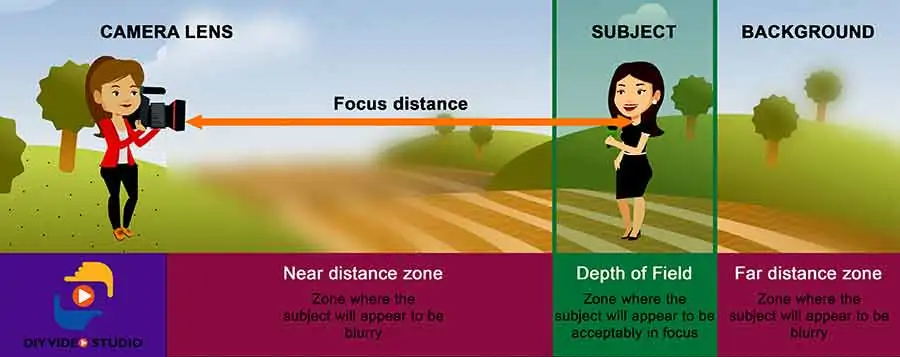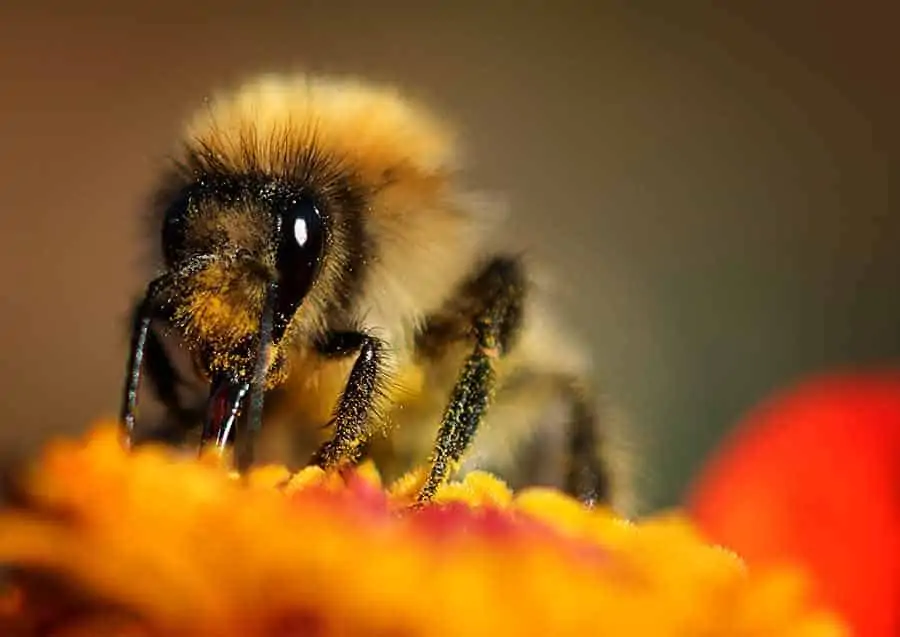DIY Video Studio is supported by its readers. Please assume links on this site are affiliate links or ads, and that I get commissions for purchases made through these links. As an Amazon Associate, I earn from qualifying purchases. Thank you if you use any of the links.
What is Depth of Field?
The Depth of Field in a shot it’s the zone where your subject will appear to be in focus. Strictly speaking, only the plane at the focus distance is in focus. But there will be a region in front and behind the focus distance in which the subject will appear to be in focus to the human eye. So, what affects depth of field?
In the illustration below, the Depth of Field (DOF) is the green zone. Anywhere in front of the camera that is outside this green zone, or the depth of field zone, will appear blurred. Furthermore, the further away an object is from the focus distance, the blurrier it will appear to be.

What affects Depth of Field
There are five factors that affect the depth of field of your camera. However, there are only three factors that you can control on your camera and these are the first three in this list.
- Lens focal length
- Subject distance to camera and background
- Lens aperture or f-stop
- Camera sensor size
- Circle of Confusion
As I mentioned, realistically you can only vary the first three factors: Focal length, Focus distance, and Aperture. This is because the sensor size is fixed in your camera, the only way you can change this as a factor is to use a different camera. Also, the Circle of Confusion also depends on the sensor size (plus one or two other factors).
So truly, the question we posed should be, “what three factors affect depth of field”. Even so, let’s look at those five factors, especially since some readers may argue that the camera’s sensor size can be changed electronically. I can, in fact, do this on the Canon EOS R, effectively changing it from a full-frame camera to a crop sensor camera.
Lens focal length
Depth of Field and focal length are linked. Generally, a long focal length lens will produce a shallow depth of field. Of course, the opposite is also true, a short focal length lens will produce a deep depth of field.
So, a telephoto or long focal length lens (say 85mm and upwards, on a full-frame camera) will produce a shallower depth of field and blurry backgrounds (and foregrounds). This is exactly what you will be after when shooting portrait or head and shoulder shots.
A wide-angle or short focal length lens (say 24mm and under, on a full-frame camera) will have a deep depth of field where more of the space in front of the camera appears to be in focus. So wide-angle lenses are ideally suited to landscape shots, where you want all or most of the shot to appear in focus.
Subject distance to the camera and background
As you come closer to your subject the depth of field will become shallower. In other words, for a shallow depth of field in your shot, get the camera closer to your subject.
You will quickly notice the shallow depth of field effect if you try some macro photography or videography. You can see in the photograph of the bumblebee that there is a very shallow depth of field. The bee’s head, front leg, and mouthparts appear in focus but everything in front and behind is blurred.

But the distance between your subject and the background is also important. In terms of the mathematics that determines the depth of field, this distance does not affect the Depth of Field. However, the further the background is from the subject the blurrier it will appear to be. You can see this in the next photograph of wooden fence posts. As the posts get further behind the plane where the subject is in focus, they get increasingly blurry.

For a more cinematic look, open up the distance between background (or foreground) objects and your subject. You can then do a rack-focus from a foreground object to your subject.
Lens aperture or f-stop
Depth of field and aperture go hand in hand. As the aperture in a camera lens increases (i.e. the f-stop number decreases), the shallower the depth of field will become. In other words, as you open your aperture, more of your background goes out of focus.
For landscape shots, where you want a deeper depth of field, you would select a higher f-stop or smaller aperture. But if you want a shallow depth of field, you will select a lower f-stop on the lens.
We can demonstrate the difference between using a small and large aperture by setting up some dominoes with a 3/4 inch (2cm) spacing. The first image below had a small aperture (f/22) and all twelve dominoes appear in focus. In the second image, I use a larger aperture (f/4) resulting in a shallow depth of field where only the 5, 4 and 1 spot dominoes are in focus.

We can see in the above image that all the dominoes appear in focus when shot with a 70mm focal length lens at f/22.

In the above image, with the 70mm lens stopped down to f/4, we have a shallow depth of field and the further a domino is from the focus distance the more blurred it appears
Camera sensor size
Sensor size does affect the depth of field in your image.
If you have a full sensor camera and a crop sensor camera (APS-C camera with a smaller sensor) and take a shot on each using the same lens at the same aperture setting and at the same distance to the subject, the camera with a smaller sensor would produce a shallower depth of field.
But hold on. The same lens on a full-frame and a crop sensor camera would produce two quite different shots.
Getting the equivalent field of view
The same lens on the crop sensor camera will effectively have a longer focal length of 1.5x or 1.6x for Canon APS-C cameras. So, the subject would appear larger in the shot taken with the crop sensor camera than the full-frame camera. For both shots to appear the same they must have the same field of view. Therefore, we need to move the full-frame camera closer to the subject or have equivalent lenses on the two cameras.
The focal length of the lens on the full-frame camera must be the crop factor of 1.6 (or 1.5 on non-Canon cameras) multiplied by the focal length of the lens on the crop sensor camera. If we are using a Canon 80D (a crop sensor camera) with a 50mm lens then the equivalent lens for our full-frame camera, say a Canon EOS R, would be an 80mm lens.
With both cameras now producing an equivalent field of view, does the smaller sensor still have a smaller depth of field?
The results from a depth of field calculator
Say our two cameras are side-by-side, exactly 6.5ft (2m) from the subject. For the Canon 80D (50mm lens) we calculate a DOF of 30.04cm. But for the EOS R (80mm lens) we calculate a DOF of 18.18cm. So when our aim is to produce a shot with a certain framing, using equivalent focal lengths, the full-frame camera, with the larger sensor, wins in the shallow depth of field stakes. For a mathematical explanation
I would recommend reading Todd Vorenkamp’s article on the B&H website.
Putting the math aside, for the composition to look the same on both the crop sensor and full-frame cameras, the latter will need a longer lens (or be closer to the subject).
From above, we know that both having a longer focal length and being closer to the subject produces a shallower depth of field. Therefore, the camera with the larger sensor will produce the shallower depth of field.
However, since the sensor size in your camera is fixed, in practice for the purposes of altering your depth of field sensor size can be ignored.
The Circle of Confusion
The last factor that determines the depth of field is the circle of confusion.
Under standard viewing conditions, the circle of confusion is the largest blur spot that the human eye will still perceive as a point. The blur spot, or circle, is formed by the converging cone of light focusing either before or beyond the camera’s sensor.
The actual size of the circle of confusion varies according to camera sensor size. To be honest, the Circle of Confusion, just like its name, can seem a bit confusing, so I’m not going to go into details. But if you would like to read about it and how it varies with sensor size, check this article on Wikipedia.
In the meantime, since you would need to change your video camera to affect the circle of confusion, we can ignore this factor.
Summary
To summarize what affects depth of field, in practical terms, I would include the following three factors:
- Aperture
- Camera to subject distance
- Lens focal length
For a shallow depth of field use a longer lens or if you have a zoom lens zoom in. You will have to move further back to frame your shot correctly. Now also open your aperture by dialing down to your lowest f-number.
For a deeper field of view use shorter focal length lenses and smaller apertures (higher f-numbers).
One use of the depth of field effect for photographers and videographers is to use background blur to isolate the subject from the background. I have written an article about this that you can read it by clicking here. Using this technique, you can blur the creases in a cloth backdrop to give it a more pleasing appearance.
To read my guide to depth of field with an iPhone follow this link.
Tosh Lubek runs an audio and video production business in the UK and has been using the Canon EOS R since it was released in the Autumn of 2018 and the Canon EOS R6 in 2020. He has used both cameras to shoot TV commercials broadcast on Sky TV, promotional business videos, videos of events and functions, and YouTube creator content. He has also won several international awards for his advertising and promotional work. You can meet him by visiting his “video booth” at HashTag Business Events across the country.
Recent Posts
You're Using the Canon RF 50mm f/1.8 WRONG! Here’s How to Fix It
If you’ve recently picked up the Canon RF 50mm f/1.8 STM—affectionately known as the Nifty Fifty—you might be confused by that strange switch on the side of the lens. It doesn’t say AF/MF...
Recently, I shot several customer testimonial videos in 4K for a client when the overheating warning on my Canon EOS R6 appeared. In fact, it appeared three times in five sessions during the day of...

